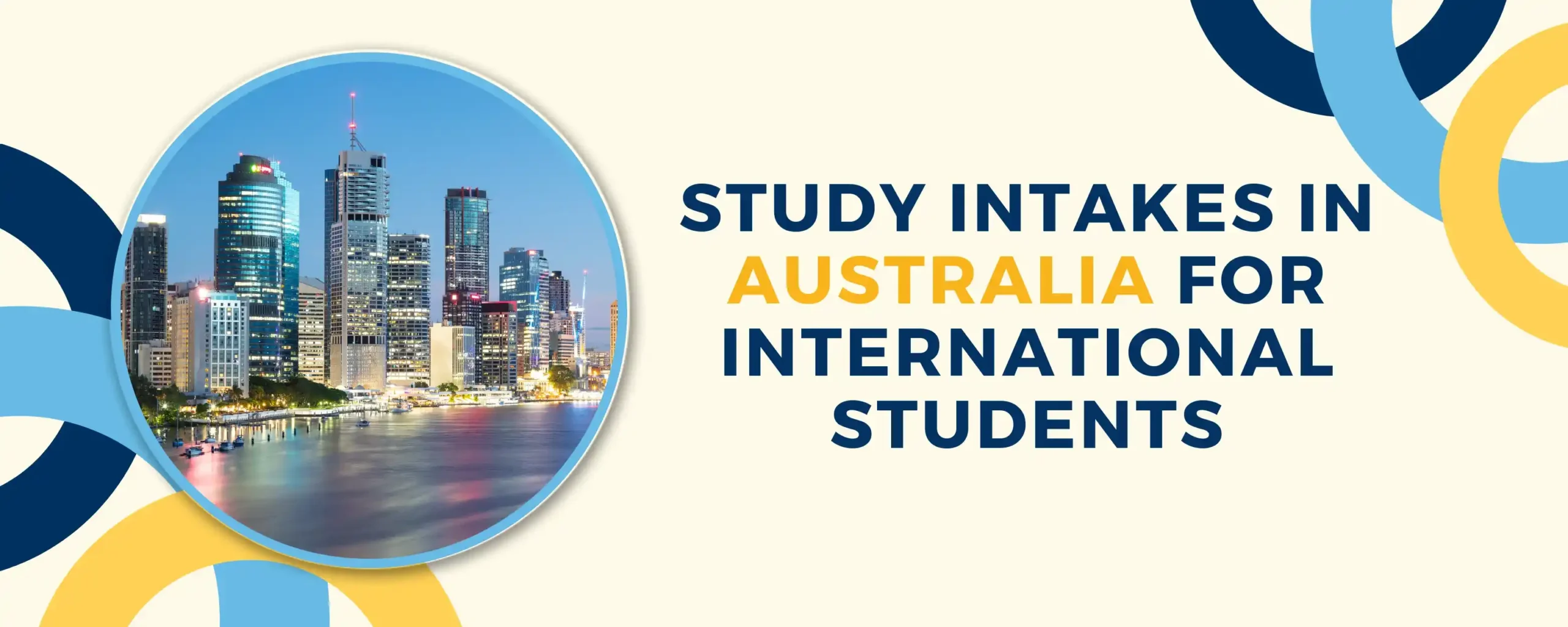Studying in Australia is a dream for many, and it’s no surprise given the country’s world-class education system, multicultural environment and breathtaking landscapes. Over 900,000 overseas students are expected to enroll in Australian higher education in 2025. Because of the great demand and competition, it can be difficult to obtain admission. But if you know the right time to apply, you have higher chances to get into your dream Australian University. Understanding these intake cycles can truly make or break your admission process. So, let’s take a closer look at the major intakes, application timelines, and tips for a smooth admission process in 2025.
Overview of Study Intakes in Australia
Unlike many countries that offer a single admission period, Australian universities operate on a multi-intake system. This means international students can choose when to begin their studies based on course availability, visa timelines, and personal plans. The flexibility helps students better plan their academic journey and settle comfortably into their new life abroad. Here’s an overview of the three main intakes:
| Intakes | Duration | Popularity |
| February Intake | February – June | Most popular and significant |
| July Intake | July – November | Favourable option |
| November Intake | October – January | Less preferred |
Major Intakes in Australia for 2025
With these options available, you might be wondering which is the best intake for you. Let’s see pros and cons of each intake so that making the decision becomes easier for you.
February (Semester 1) Intake
The February intake is the main and most popular admission period in Australia. Most universities offer a wide range of undergraduate and postgraduate courses during this intake. You also get access to various scholarships and internship opportunities in this intake. By joining the February intake, you can get a head start on your studies and complete your degree sooner. However, you must note that it’s also the most competitive.
- Key Deadlines: Applications generally open around July-September of the previous year (2024 for 2025 intake) and typically close by late October to mid-December 2024.
- Top Universities: University of Melbourne, UNSW, Monash University, University of Queensland, Australian National University, University of Sydney, and many more.
- Why Apply: More course options, better chances for scholarships, and maximum time for internships and job opportunities, early degree completion.
July (Semester 2) Intake
Known as the mid-year intake, July is the second major admission period in Australia. It is ideal for students who miss the February deadline or want more preparation time. You’ll have ample time to prepare your applications, finish previous studies, or improve your English proficiency scores.. You can access a variety of courses (though not all) and scholarship options during this intake. As well as the rate of acceptance is higher, as compared to the February intake, as the competition is lower.
- Key Deadlines: Application period is typically between February and March during the same year and applications close between March to May.
- Top Universities: Most major universities participate, but course availability may vary.
- Benefits: Less competition, more time for visa processing and prepare documents, entry into mid-year programs, availability of part-time job opportunities during the semester break.
- Challenges: Fewer course options and slightly fewer scholarship opportunities.
November (Summer/Trimester) Intake
As compared to the first 2 intakes, Semester 3 is not as popular because November is when the summer season begins – meaning less crowded academic environment and fewer courses and universities. It is perfect for specific programs or fast-track courses. It has a less crowded academic environment. On top of that, scholarships and financial aid are the most limited in this intake. However, the best thing about Semester 3 is the fact that you’ll have the least competition when it comes to getting into your desired course – which means your chances of having a successful application are the highest if you apply for this intake
- Key Deadlines: Applications generally open around July-August and typically close by late August-September.
- Top Institutions: Bond University, University of New England, University of Newcastle, Griffith University and a few others. It is best for short courses, diplomas, and some business or IT programs.
- Pros: Quick entry into studies, less crowded admissions, shorter wait time and faster graduation, flexibility for gap year students
- Cons: Limited university and program choices.
Choosing the Right Intake for You
It can get a bit confusing to choose the intake that’s best for you. Thus, you need to factor in several things such as the availability of courses, acceptance rates etc. Consider the following factors:
- University Preferences: Not all universities offer all intakes. Check if your preferred university accepts applications in February, July, or November, as availability may vary depending on the course and institution.
- Course availability: Some programs are only offered in specific intakes. You need to check if your desired course is available in your chosen intake. February has more options, whereas July and November have fewer programs.
- Visa Processing Time: Choosing an intake like November may give you more time to get your student visa processed smoothly without last-minute pressure.
- Career Goals: Intake dates can be associated with internship timings, job openings, or the timeliness of any postgraduate program. If you want to finish early and start working sooner, February intake is ideal. But if you need more prep time for entrance exams or internships, July or November may work better for you.
- Availability of Scholarships: Assess if you have sufficient funds ready for fees and living expenses for your preferred intake. If not, you can apply for scholarships. Maximum financial aid is available for the February intake.
- Competitiveness: If the student’s academic profile is average, the reduced competition in July and November may increase the admission chances.
Ultimately, the decision of which intake to choose in Australia will depend on a variety of factors, and it is recommended to speak with an education counsellor to determine the best option based on individual needs.
Application Process and Deadlines
Your admission to Australia may be successful if you monitor deadlines and apply as early as possible. The application process for intakes in Australia starts a year before the intake, so one should prepare for this time and the pre-application requirements. Here is how to plan before and apply for intakes in Australia:
| Months | Timeline | Actions |
| Research and Planning | 1 year before | Research Australian universities and the programs they offer. |
| Choosing Universities and Programs | 9-8 months before | Shortlist universities and courses based on your interests and requirements. Check the entry requirements |
| Gather required documents for application | 7-6 months before | Prepare the necessary documents, which may include financial records, academic transcripts, certificates, English language test scores (like IELTS or TOEFL), a valid passport, a statement of purpose (SOP), letters of recommendation (LORs), and a resume. |
| Application Submission & acceptance | 5-4 months before | Submit your application to selected universities. Apply for scholarships. The university will send you an offer letter if your application is successful. |
| Visa Procedure & | 4-3 months before | Once you have accepted the offer, you’ll need to apply for a student visa (Subclass 500). |
| Pre-departure Preparation | 2-1 month before | Pay tuition fees and deposits. Arrange accommodation and flights. Familiarize yourself with local culture and university expectations. |
Students tend to make some mistakes while applying to Australian Universities. Here’s a list of things one need to to care for:
- Starting the Application Process Late
- Ignoring Eligibility Criteria
- Applying to Too Many or Too Few Universities
- Writing a Weak SOP
- Overlooking Scholarship Deadlines
- Not preparing financial documents in advance
Scholarships and Financial Planning for 2025 Intakes
The cost of studying (AUD 20,000–45,000/year) and living costs (AUD 21,000/year) can be brought down with scholarships and proper budgeting.
Overview of Available Scholarships
Australia offers a wide range of scholarships for international students that help ease the financial burden
- Government-funded options like the Australia Awards and Destination Australia Scholarship.
- University-specific scholarships such as the University of Melbourne Graduate Scholarships or Monash International Merit Awards.
Most scholarships have early deadlines and are highly competitive. Applying early not only increases your chances of receiving funding but also shows your seriousness and preparation.
Tips for Saving Money
There are a number of things that international students can do to save money on their studies in Australia, including:
- Create a monthly budget of all expenses and spend accordingly.
- Choose a more affordable university or course.
- Live in on-campus accommodation or shared accommodation.
- Cook your own meals instead of eating out.
- Take advantage of free and low-cost activities, such as visiting museums, parks, and libraries.
- Work part-time while studying.
Visa Process and Arrival Preparation
Getting your Australian student visa (Subclass 500) is the final big step! You can apply once you receive your Confirmation of Enrolment (CoE). For Indian students, the processing time for this visa typically ranges from 4 to 8 weeks, though it can vary based on the completeness of your application and peak seasons. Remember to secure your Overseas Student Health Cover (OSHC), which is mandatory for the entire duration of your stay in Australia. Other required documents include passport, proof of funds, English proficiency scores (IELTS/PTE) etc.
What Students Should Do Before Departure
- Book accommodation early
- Learn about Australian culture and student life
- Download useful apps for transport and banking
- Stay updated with university orientation schedules
Arrival Tips for a Smooth Transition
Try to arrive a few weeks before the classes begin. Keep all important documents handy at the airport. Use university-arranged airport pickup services if available. Attend orientation programs, open a bank account, get a SIM card, and explore public transport options to settle in quickly and comfortably.
Study in Australia with Expert Guidance
Getting through the Australian university applications and visa processes can be difficult, especially with several intakes and deadlines. Professional guidance can make this journey much easier by assisting you in choosing the best intake and university matching your profile. La Forêt Education provides personalized study abroad assistance, including course selection, application aid, exam preparation, and visa processing. Explore our services for expert advice on making your Australian study ambitions a reality!
Conclusion
Hope you now have a better understanding of the upcoming intake in Australia in 2025. As you can see, there are a few different intakes to choose from, each with its own advantages and disadvantages. It is important to choose the intake that is right for you based on your individual needs and preferences.
If you are still unsure which Australia intake 2025 to choose, or if you need help with the application process, we recommend getting assistance from La Forêt Education. Start planning early for 2025, embrace the exciting opportunities Australia offers, and embark on a truly enriching academic and personal journey!
Frequently Asked Questions
1. How many intakes are there in Australia for international students?
Ans: Australia offers three main intakes for international students:
- February (Semester 1): The primary and most popular intake.
- July (Semester 2): The mid-year intake, offering a wide range of courses.
- November (Trimester/Summer): Limited programs, great for short-term or specific courses.
Each intake provides flexibility, so students can plan based on course availability, visa timelines, and personal preferences.
2. Which intake is best for Australia in 2025?
Ans: The February 2025 intake is considered the best option for most students. It offers the widest choice of programs and universities, aligns with Australia’s academic calendar, and provides maximum time for post-study work planning. However, the July intake is also a great alternative if you miss the earlier deadlines or need more time for preparation.





